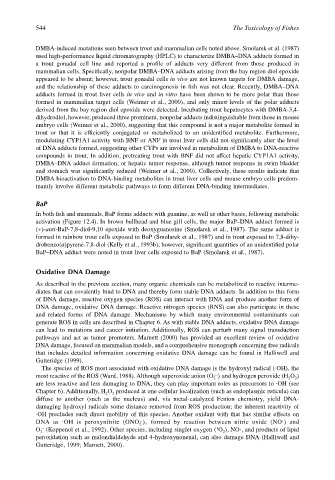Page 564 - The Toxicology of Fishes
P. 564
544 The Toxicology of Fishes
DMBA-induced mutations seen between trout and mammalian cells noted above. Smolarek et al. (1987)
used high-performance liquid chromatography (HPLC) to characterize DMBA–DNA adducts formed in
a trout gonadal cell line and reported a profile of adducts very different from those produced in
mammalian cells. Specifically, nonpolar DMBA–DNA adducts arising from the bay region diol epoxide
appeared to be absent; however, trout gonadal cells in vivo are not known targets for DMBA damage,
and the relationship of these adducts to carcinogenesis in fish was not clear. Recently, DMBA–DNA
adducts formed in trout liver cells in vivo and in vitro have been shown to be more polar than those
formed in mammalian target cells (Weimer et al., 2000), and only minor levels of the polar adducts
derived from the bay region diol epoxide were detected. Incubating trout hepatocytes with DMBA-3,4-
dihydrodiol, however, produced three prominent, nonpolar adducts indistinguishable from those in mouse
embryo cells (Weimer et al., 2000), suggesting that this compound is not a major metabolite formed in
trout or that it is efficiently conjugated or metabolized to an unidentified metabolite. Furthermore,
modulating CYP1A1 activity with BNF or ANF in trout liver cells did not significantly alter the level
of DNA adducts formed, suggesting other CYPs are involved in metabolism of DMBA to DNA-reactive
compounds in trout. In addition, pretreating trout with BNF did not affect hepatic CYP1A1 activity,
DMBA–DNA adduct formation, or hepatic tumor response, although tumor response in swim bladder
and stomach was significantly reduced (Weimer et al., 2000). Collectively, these results indicate that
DMBA bioactivation to DNA-binding metabolites in trout liver cells and mouse embryo cells predom-
inantly involve different metabolic pathways to form different DNA-binding intermediates.
BaP
In both fish and mammals, BaP forms adducts with guanine, as well as other bases, following metabolic
activation (Figure 12.4). In brown bullhead and blue gill cells, the major BaP–DNA adduct formed is
(+)-anti-BaP-7,8-diol-9,10 epoxide with deoxyguanosine (Smolarek et al., 1987). The same adduct is
formed in rainbow trout cells exposed to BaP (Smolarek et al., 1987) and in trout exposed to 7,8-dihy-
drobenzo(a)pyrene-7,8-diol (Kelly et al., 1993b); however, significant quantities of an unidentified polar
BaP–DNA adduct were noted in trout liver cells exposed to BaP (Smolarek et al., 1987).
Oxidative DNA Damage
As described in the previous section, many organic chemicals can be metabolized to reactive interme-
diates that can covalently bind to DNA and thereby form stable DNA adducts. In addition to this form
of DNA damage, reactive oxygen species (ROS) can interact with DNA and produce another form of
DNA damage, oxidative DNA damage. Reactive nitrogen species (RNS) can also participate in these
and related forms of DNA damage. Mechanisms by which many environmental contaminants can
generate ROS in cells are described in Chapter 6. As with stable DNA adducts, oxidative DNA damage
can lead to mutations and cancer initiation. Additionally, ROS can perturb many signal transduction
pathways and act as tumor promoters. Marnett (2000) has provided an excellent review of oxidative
DNA damage, focused on mammalian models, and a comprehensive monograph concerning free radicals
that includes detailed information concerning oxidative DNA damage can be found in Halliwell and
Gutteridge (1999).
The species of ROS most associated with oxidative DNA damage is the hydroxyl radical (·OH), the
most reactive of the ROS (Ward, 1988). Although superoxide anion (O ) and hydrogen peroxide (H O )
·–
2
2
2
are less reactive and less damaging to DNA, they can play important roles as precursors to ·OH (see
Chapter 6). Additionally, H O produced at one cellular localization (such as endoplasmic reticula) can
2
2
diffuse to another (such as the nucleus) and, via metal-catalyzed Fenton chemistry, yield DNA-
damaging hydroxyl radicals some distance removed from ROS production; the inherent reactivity of
·OH precludes such direct mobility of this species. Another oxidant with that has similar effects on
–
DNA as ·OH is peroxynitrite (ONO ), formed by reaction between nitric oxide (NO·) and
2
·–
1
O (Koppenol et al., 1992). Other species, including singlet oxygen ( O ), NO·, and products of lipid
2
2
peroxidation such as malondialdehyde and 4-hydroxynonenal, can also damage DNA (Halliwell and
Gutteridge, 1999; Marnett, 2000).

